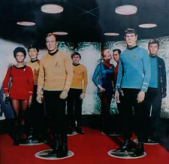 |
 |
 |
 |
 |
 |
 |
|
Build your own time machine
Surely it's not a time machine, it's Médecins Sans Frontières, right? - Unfortunately I'm not a medical person, but I'm sure their work is superb. Stand back Area51, this is THE genuine, home made, time machine and it's made in Great Britain! :-)
The MSF radio signal is a broadcast version of the central frequency standard for the UK. This concept of "standard" is something like that of the standards for a Metre or a Kilogramme. Somewhere in a protected controlled vault, lies a length of material that defines the length of one Metre. Similarly, with a Kilogramme there is a blob of stuff which weighs exactly one Kilo. Frequency standards are slightly different because they are inherently dynamic. Unlike the Metre or the Kilogramme, a Frequncy Standard is changing all the time. In particular, the long term average of that rate of change is the quantity that is stable, uniform and unchanging.
For the Metre and the Kilogramme, it is fairly easy to make an identical copy. The copy can then be moved to a new location, and another copy made. By this means, distribution of the information that the standard represents is possible and straightforward.
For the Frequency standard, this is not so easy. Modern physics describes and demonstrates concepts and implementations for "quantum entanglement". This is a scheme where the states of nuclear or quantum mechanical objects can be synchronised. These objects can be transported to separate locations, and their states inspected. In some circles this is described as a stepping stone to "faster than light transport" or "teleportation". Some of these ideas are quite reasonable. Quantum entanglement, with some provisos, could certainly be used for the dissemination of a frequency standard, but the grander claims seem some way off. Not wishing to completely let go of practicality, even the use of quantum entanglement for such mundane things as the distribution of a frequency standard, is some way off. In the mean time, radio represents a close second! Even radio has it's limitations, and I'll discuss these later. In the main people who have never heard of MSF will think of the signal as "The PIPS". They are broadcast hourly on BBC Radio 4, but also less frequently on other BBC radio and TV stations, and on other networks. The basic signal broadcast is derived indirectly from the master reference owned managed and operated by the National Pysical Laboratory (NPL). The MSF time signal is broadcast from from the ex RNAS Anthorn site in Cumbria, HMS Nuthatch. The actual signal is broadcast at 60KHz, 100% modulation, in an asynchronous serial format at the rate of 10 baud (10 symbols per second), at a nominal 17kW. The 60KHz carrier is derived from a highly stable caesium frequency standard which is located at the Anthorn site, and which also generates the date, time, and metadata modulated onto the carrier in serial format.
The NPL monitor the MSF time signal (among others), and they provide a monthly bulletin of of the error they measure in the signals they receive. One can only watch these errors to understand exactly how much drift is present in each of these references. By this method, one may receive the MSF, and other related time signals and use them as a tracable frequency standard. It is notable that there is more drift than one might expect. Before I started researching this subject, I'd assumed that drifts would be measured in femto or atto seconds. How wrong I was!! In practice dissemination and "integral synchronisation" is a problem that Einstein would, I'm sure, have been proud to take on. Time is an open ended problem, and we only have the universe to measure it with. I guess then, it's understandable that there are errors. We must be happy that humans are sociable beings, sometimes able to at least agree our differences! Ultimately, it would seem that the atomic standards around the world tick away at their fundamental frequencies. They are compared and contrasted in a scientific and technical, peer to peer relationship. They do directly control the day to day ticking away of the hours, minutes and seconds. Their accuracy is superior to that of the solar system that we measure "ordinary time" against. At the end of the year the numeric time and date sits atop these standards, and thus solar mechanics dictates the numbers applied to the integral atomic frequency counts. It is unlikely that the Greenwich Observatory specify the end of the year to an attosecond precision, but ultimately atomic clocks like those at the NPL must submit to practical observations of time and date. By this means any atomic drift pales into insignificance. The frequency standards tick on unhindered, date and time are applied on top. Whilst the MSF radio system distributes a single signal, it is really composed of two quite distinct quantities.
The basic "Einstein" relativity problems pervade fundamental measurement of time. It is virtually impossible to synchronise clocks in different locations, to any significant degree of precision. In general, more mundane practical problems limit this capability. For the MSF signal, it's down to radio reception, and the variability of signal to noise ratio, phase noise, and signalling abberations. Over time, and with progress, the technology has improved, and is set to improve some more. Nevertheless, the basic problems Einstein observed and predicted, will never change. |
Copyright © Solid Fluid 2007-2025 |
Last modified: SolFlu Fri, 19 Apr 2013 21:41:40 GMT |


